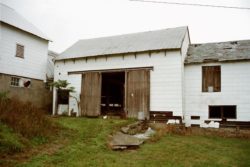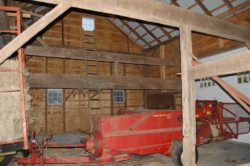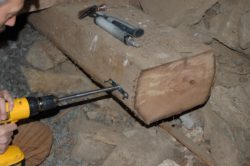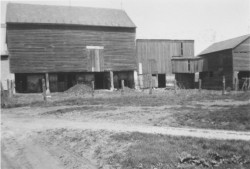By Carla Cielo, Architectural Historian, Historic Preservation Consultant, Designer, and longtime NBA member. Two articles on this dendrochronology project have been previously published in the Barn Journal. Check out both stories: Part 1 & Part 2!
(The Historic Preservation Commission of Holland Township, New Jersey, hired ‘Oxford Tree Ring Dating’ to date nine barns with dendrochrolology. This study has been funded, in part, with grants provided by the New Jersey Historical Commission. It was hoped that a study of this kind would answer questions related to ethnic settlement patterns.)
 The first barn dated with dendrochronology in Holland Township was the Hammerstone Barn – a ground-level, three bay, heavy-timbered, swing beam barn that is located in the hilly section of the township about 8 miles inland from the Delaware River. This preliminary dendrochronology study was completed in 2007 by a colleague who provides dendrochronological services as a side venture. Only 3 samples were taken from the floor structure in a crawlspace: one from a girder that supports the joists at midspan in the crawl space of the west bay and 2 from floor joists. No samples were taken from the main barn frame. Samples were sent to a lab for analysis. The dates were non-conclusive: sample #1 dated 1787, sample #2 gave no date, and sample #3 dated 1785. The possibility of a 1787 construction date was assumed.
The first barn dated with dendrochronology in Holland Township was the Hammerstone Barn – a ground-level, three bay, heavy-timbered, swing beam barn that is located in the hilly section of the township about 8 miles inland from the Delaware River. This preliminary dendrochronology study was completed in 2007 by a colleague who provides dendrochronological services as a side venture. Only 3 samples were taken from the floor structure in a crawlspace: one from a girder that supports the joists at midspan in the crawl space of the west bay and 2 from floor joists. No samples were taken from the main barn frame. Samples were sent to a lab for analysis. The dates were non-conclusive: sample #1 dated 1787, sample #2 gave no date, and sample #3 dated 1785. The possibility of a 1787 construction date was assumed.
After dating six other ground-level, swing beam barns that ranged in date from 1794 to 1812, the 1787 date was questioned. The character of the framing of the Hammerstone Barn looks far more advanced (younger) in its construction methodology than barns that dated to the 1790s. For example, the interior bents of the 1794 James Salter Barn are framed with just two unconnected cambered tie-beams. Whereas in the Hammerstone Barn, struts and passing braces are incorporated into the swing beam bent to join the upper and lower tie beams. This is characteristic of the ground barns that dated after 1803 in Holland Township. It was, therefore, decided to date the barn again using a professional dendrochronologist who operates his own in-house lab. The findings were interesting, to say the least.
 This time 7 samples were taken in the barn: 3 from the upper barn frame and 4 from the floor joists (including one joist that had been sampled previously). Two samples revealed that the trees from which the timbers were cut were felled during the winter of 1803/04 suggesting that the barn was built in the spring of 1804. The five remaining samples, unfortunately, could not be dated. The 1804 date, however, is “right on” when compared to the construction details of several other dated barns.
This time 7 samples were taken in the barn: 3 from the upper barn frame and 4 from the floor joists (including one joist that had been sampled previously). Two samples revealed that the trees from which the timbers were cut were felled during the winter of 1803/04 suggesting that the barn was built in the spring of 1804. The five remaining samples, unfortunately, could not be dated. The 1804 date, however, is “right on” when compared to the construction details of several other dated barns.
To add further interest, the data was run again on the three samples that were taken in 2007. One of them did indeed date to 1787. Another matched the chronology of the sample that dated 1787 up to 1758 with a “t-value” of over 11. The “t-value” provides an indication of the quality of the match against a reference chronology. A t-value greater then 5 indicates a regional match; above 10 suggests that the samples came from the same tree. In this case, the t-value over 11 indicates that two joists were cut from the same tree and that the sapwood was probably lost from the latter sample. Does this indicate that at least some of the joists were reused from a 1787 structure? Or does it indicate that the sapwood was lost from both samples and that both would date to 1804 if the sapwood remained? Since the core drills appear to have been lost, we likely will never know. It is surely tempting to fantasize a former 1787 log structure being reused as floor joists! But if this was the case, wouldn’t a 1787 date have been re-identified by the second dendrological study?
 In conclusion, dendrochronology is a highly valuable tool, but it must be part of a comprehensive study which takes into account a variety of methods to date a building (saw cut, nails, framing methodology etc.). Propagation of a false date can be detrimental to future barn historians.
In conclusion, dendrochronology is a highly valuable tool, but it must be part of a comprehensive study which takes into account a variety of methods to date a building (saw cut, nails, framing methodology etc.). Propagation of a false date can be detrimental to future barn historians.

